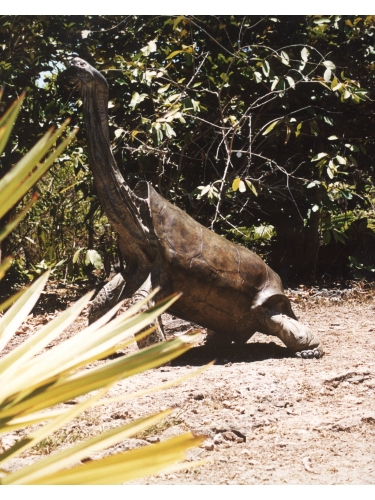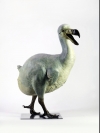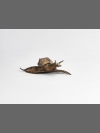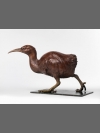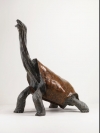
Bones to Bronze
Extinct Species of the Mascarene Islands
8th March - 16th April 2004
Shivers must surely go up the spine of anyone who visits this exhibition, for the eleven bronze sculptures all represent creatures that have vanished from the face of earth. There is something unnerving about the fact that they are gone forever, driven out of existence by the carelessness and greed of mankind. The reconstructions take up very little space, yet they have positively global significance, since they represent the latest initiative in an ambitious and imaginative campaign to slow down the tide that is sweeping thousands of species towards extinction.
These birds and reptiles once lived on the Mascarene Islands - Mauritius, Réunion and Rodrigues – way out in the Indian Ocean to the east of Africa. Easily the most celebrated is the dodo, flightless and comically misshapen, which disappeared in the 1660s, and one of the most recent casualties is the lesser fruit bat, which hung on until the middle of the 19th century.
The idea of making reconstructions came from Dr Carl Jones, the biologist who for the past 25 years has worked as director of the Mauritian Wildlife Foundation, running the island’s unique fauna conservation programme. Together with Rungwe Kingdon and Claude Koenig, directors of the Pangolin Editions sculpture foundry at Chalford, near Stroud, he conceived the notion of recreating lost species, and deploying the bronze sculptures on the Ile aux Aigrettes, a 35-hectare islet off the south-eastern shore of Mauritius, which is now a nature reserve and has become the Foundation’s showpiece.
The little island has been cleared of exotic vegetation, and the indigenous flora, such as ebony trees, are being re-established. Alien creatures like rats, rabbits and wolf-snakes, thoughtlessly imported by early sailors, have also been removed, and some of the original inhabitants have been restored, among them the pink pigeon and the Mauritius kestrel - both retrieved from the brink of extinction by careful breeding programmes. Yet in all there are fourteen species which can never be brought back to life and eleven of the bronzes are already sited on the islet as part of a trail which visitors can walk.
What cannot be immediately apparent, either on Mauritius or here, is the astonishing amount of research that has gone into the recreation of each bird and animal. The Pangolin team, supported by Nick Arnold of the Natural History Museum, author Errol Fuller and the independent experts Anthony Cheke and Julian Pender-Hume, went to extraordinary lengths in search of authenticity, researching early reports of the various species, and hunting down the scant remains. The pooling of their scholarly research enabled the sculptor Nick Bibby to model the creatures in clay, from which the bronzes have been cast.
Duff Hart-Davis
February 2004
For further information see www.extinct-species.com
